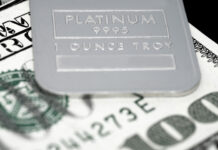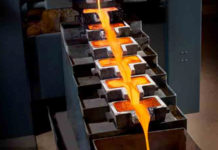
THE prospect of regional conflict in the Middle East has given gold a boost in another example of what former AngloGold Ashanti CEO Bobby Godsell once lamented was the metal’s “catastrophe status”. When he said this, in the 1990s, AngloGold Ashanti was working hard to promote gold as adornment, but jewellery is only a shiny sliver of its appeal.
So is geopolitical tension, it would seem. The recent premium in gold arising from the Middle East conflict is a volatile one, and not a reliable driver of long-term value, says UBS. “It makes the market vulnerable to headlines,” says Joni Teves, a precious metals strategist for the Swiss bank.
The likelihood that recent gold purchases have been speculative is underpinned by the behaviour of private money. There is yet to be a convincing turn in the buying of exchange traded funds, suggesting private wealth is already well allocated to the metal and may even liquidate. Official sector buying has been robust, however. Central banks bought an estimated 1,000t of bullion in 2022, double the amount of 2021.
But what really matters in gold, the experts say, is performed on the macroeconomic stage, starting with the US Federal Reserve and its interest rate policy. The relationship between interest rates and gold is complicated.
It’s often said there is a negative correlation between rates and gold, but not always. There are times when gold and rates increase, such as in the 1970s. More recently, gold had a trough-to-peak rally of nearly 28% and missed the record in 2022 by less than $10 an ounce, during which time the Fed took policy rates to levels not seen since before the 2008 global financial crisis, according to Metals Focus, a UK research house.
Nonetheless, the Fed’s “extraordinary” run-up in rates with the re-emergence of inflation is creating an opportunity, believes John Reade, a former analyst and chief market strategist at the UK-based World Gold Council.
“Quite how many rate hikes from the Fed are still to come — is it one or two, or possibly none? — that is by the by,” he says. “What we know is that the next big move from the Fed, after a period of pausing, is rate cuts, which should be supportive of gold.”
More bank trouble?
Financial distress could also be consequential for gold. The council has a medium-term forecast of $1,800-$2,000 an ounce for gold. It last looked like testing the upper end of that guidance between March and May when a banking crisis, headed off by UBS’s $3.3bn purchase of the struggling Credit Suisse, triggered a bout of safe-haven gold buying.
According to Rhona O’Connell, head of market analysis, Europe, the Middle East and Africa and Asia for StoneX, a US financial services company, the cost of capital is threatening to spark fresh pressure in banking. This could be among middle-order institutions that support medium and small businesses in the US, responsible for 60% of the country’s productive GDP, she says. “Even if there are no more hikes, that cost of capital will feed through to those middle-order banks,” says O’Connell. The question is the extent to which those banks can shore up balance sheets without having an impact on the industry.
“I don’t think we have seen the last of it. I think there are stresses and strains within the [banking] system. I wouldn’t at all be surprised to see problems in the next six to nine months, which is when gold will come back as a safe haven and take centre stage,” says O’Connell.
If this still sounds as if gold’s prospects are being conceptualised in terms of impending disaster, you’ve not read nothing yet. Mark Bristow, CEO of Barrick Gold, the world’s second-largest gold producer, has long argued the systemic underpricing of gold. He thinks that by having failed to properly tackle the financial and economic crises of 2008, principally by printing money, the West has only bought respite. “Critical issues” built on 2008, as well as the way banks dealt with the economic torpor of the pandemic, loom large, he says. “When you look at critical risks in the global economy in a de-globalising world there will be an ever-growing move towards the only currency politicians can’t print, which is gold,” says Bristow.
To a large extent, gold has never stopped acting as a safe haven. That the metal has bobbed around $1,800-$1,900 an ounce all year, even in this high rates environment, indicates a high level of resilience. “Bitcoin was supposed to rival gold as a hedge against risk,” says AngloGold Ashanti CEO Alberto Calderon. “But bitcoin runs away from risk. Gold has been around for 4,000 years. It won’t disappear.”











